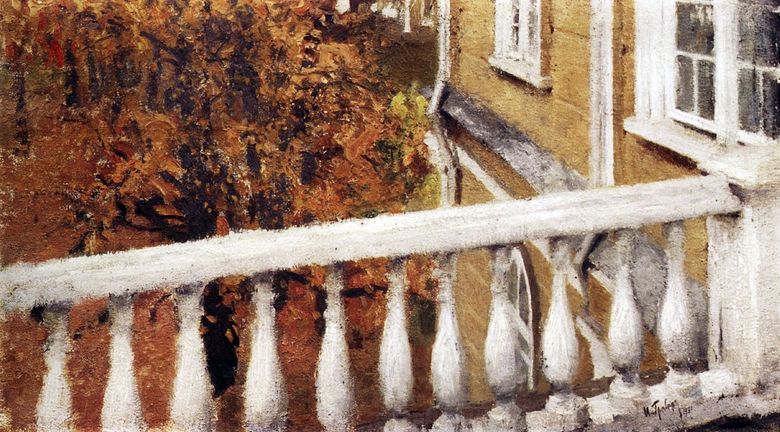
The fourth exhibition of paintings “World of Art”, held in 1902 first in St. Petersburg and then in Moscow, brought Igor Emmanuilovich Grabar not just recognition, but a stunning success, which is especially important, “mainly among artists.” Grabar suddenly became famous. He was elected a member of the World of Art. Even before the opening of the exhibition, the Tretyakov Gallery and the Alexander III Museum were arguing about replenishing their collection with one of the nine Grabar landscapes presented to the show. It was densely “Ray of the Sun”, the owner of which, at the request of the author himself, was the Tretyakov Gallery.
Other works that caused genuine interest among the public were also bought. Among the works of Grabar, purchased from the exhibition, was the painting “Balustrade”, which decorated the private collection of the manufacturer Ivan Morozov, known among collectors for his interest in the works of French and Russian painting of the late XIX – early XX centuries. Subsequently, he still repeatedly bought the picturesque works of Grabar. Landscape “Balustrade” was created by the artist in 1901 in the Moscow estate family estate of the Shcherbatov princes of Naro-Fominsk. There, in August-September, Grabar was at the invitation of his friend Sergei Aleksandrovich Scherbatov, painter, collector, author of the memoir “Artist in a bygone Russia.”
The acquaintance of Grabar and Shcherbatov took place in 1898 in Munich in the drawing school of Anton Ashbe, where Igor Emmanuilovich taught for a while. Grabar, recalling the Munich period of his life, wrote that Shcherbatov “was very talented, quickly grasped the slightest hints and soon… left behind the other disciples.” In January 1901, Grabar returned to Russia after a long trip to Europe, which he “made for a detailed and in-depth study of world art…”. It was abroad that Grabar came to the final conviction that “the artist must sit at home and depict his, his close and native life.”
Upon his return to Russia, according to the artist himself, “his most creative period” begins. Once again after a long separation he fell in love with Russian nature. In the suburbs Grabar worked a lot in the air. The lessons of French Impressionism, which became a complete victory of the principle of sensory, visual authenticity – attention to light and air, to the atmospheric game, to the fluidity of life, led Grabar to master this system, primarily in the genre of landscape. Painting of the artist, alien to the staging effects, seeks in the random of genuine value. It seems that the landscape of “Balustrade” is written easily, in one breath. Despite the fragmentation, the composition is thought out. It allows the viewer involuntarily in his imagination to push the limits of the canvas and perceive the visible as part of a vast world,
For Grabar, nature itself becomes the bearer of a gamut of feelings, and he sees his task in creating its color image. And you feel that the spiritualized flesh of the paint, a free, textured smear that preserves the plasticity of the forms, is capable of transmitting both the smell of pale leaves and spicy, like a trembling air saturated with wilting. The vibrant autumn light combines the “proscenium” – part of the house, the balustrade itself, which develops dynamically with an active diagonal, and “distance” – into a beautifully merged whole. His feelings and feelings the artist matches with the state of autumn. And it is obvious that the picturesque system of impressionism is synthesized in the work of Grabar with the lyrical features of Russian pictorial tradition, coming from Polenov and Levitan. The artist goes into the world of man’s merging with nature, into a world of inner harmony,
 Balustrade – Igor Grabar
Balustrade – Igor Grabar Rowan by Igor Grabar
Rowan by Igor Grabar Ryabinka by Igor Grabar
Ryabinka by Igor Grabar On the lake by Igor Grabar
On the lake by Igor Grabar Unattached table by Igor Grabar
Unattached table by Igor Grabar February azure by Igor Grabar
February azure by Igor Grabar March snow by Igor Grabar
March snow by Igor Grabar Winter landscape by Igor Grabar
Winter landscape by Igor Grabar